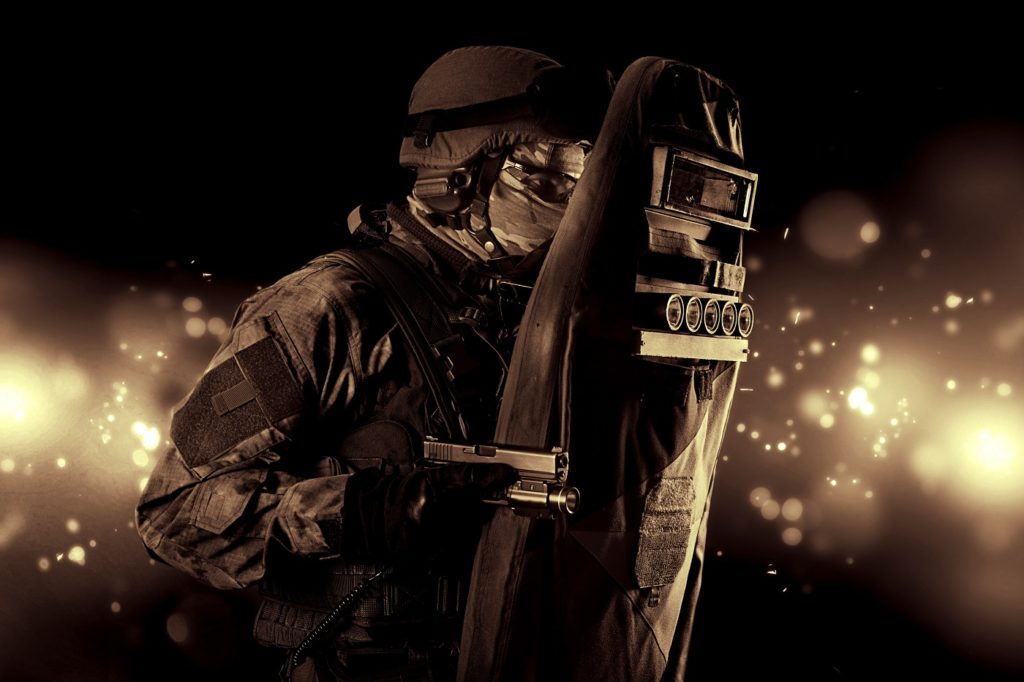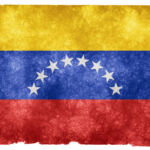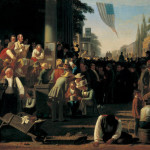My home of Oregon has always been radical. This summer, though, media attention turned to Portland in a new way. We found ourselves in the national spotlight and unable to tell what was really going on in our own city. After getting in an argument over whether downtown was actually a “war zone,” I decided to go and see for myself, recounting that experience in a report for Breaking Ground. Since that piece was written, the protests have continued, and tensions have built between far-left and far-right groups. I started attending because I wanted to see what was happening in my city. I have continued to go and interview people, including Proud Boys and members of Antifa—people at the extremes of our political conversation—because doing so has helped me understand the causes of the extremism and political polarization that is gripping this country.
The Protest Movement in Portland
I attended anti-police protests in July, August, and September, and a Proud Boys rally in September. At both sorts of events, many people showed up “dressed for a fight.” They wore helmets and carried gas masks and plastic shields. At the Proud Boys rally, I saw ASP wands, baseball bats, and paintball guns. The people I spoke to on both sides told me that they would only act in self-defense. They pointed to instances of violence perpetrated by people on the other side. One man carrying a baseball bat at the Proud Boys rally told me “you won’t see one of us throw the first punch.”
And yet violence frequently erupts when protesters and counter-protesters meet at these events. They are powder kegs, and all that is needed is for one person to snap in order for each side to feel justified in acting violently in “self-defense.” The man who told me that a Proud Boy would not throw the first punch was very comfortable admitting to me that, if violence were to break out, he would take part in it. This reflects a broader trend in American politics: people on both left and right are increasingly comfortable with the use of violence to bring about their own political aims. According to Politico, “36 percent of Republicans and 33 percent of Democrats said it is at least ‘a little’ justified for their side ‘to use violence in advancing political goals’—up from 30 percent of both Republicans and Democrats in June.”
Start your day with Public Discourse
Sign up and get our daily essays sent straight to your inbox.Little dialogue takes place. If people from the opposing side are present at all, it is as counter-protesters. Each side loudly and aggressively denounces the other for views they believe them to hold.
At the Proud Boys rally, speaker after speaker got up to denounce the Marxism they saw as taking over the United States. There were multiple chants of “F—k Antifa!” (one followed immediately by a lengthy prayer). At the anti-police protests, the people I spoke with condemned fascism and white supremacy, both of which they held to be extremely common views in society. Members of both sides tend to demonize the other, maybe unconsciously, by invoking the most extreme and hateful views they believe it represents.
For example, the Proud Boys have vehemently denied claims from the Southern Poverty Law Center that they are a racist group. Both the people I spoke with and those who addressed the crowd reinforced this message. At their rally, the only overt evidence of racism I saw was one woman carrying a Confederate flag. She was surrounded by about twenty reporters. Most of what people told me they cared about could fit easily within the mainstream conservative political aims: lower taxes; less government regulation; more free speech. I spoke with Enrique Tarrio, the Afro-Cuban leader of the Proud Boys. He said he believes that the Black Lives Matter movement is “being co-opted by Marxists with a different agenda” and asked what burning down cities did for the memories of George Floyd and Breonna Taylor. At the same time, the group describes itself as being “Western chauvinists,” and Tarrio told me he sees no problem with American exceptionalism. But when the Proud Boys are discussed in the media, it is without nuance. They are described, as happened at the first presidential debate, as a white supremacist group, and it is left at that.
At these events, little dialogue takes place. If people from the opposing side are present at all, it is as counter-protesters. Each side loudly and aggressively denounces the other for views they believe them to hold. When I interview people at protests, I find that they rarely hold the views they are attacked for. They are usually not filled with hate, as their opponents believe. However, they often consume one-sided media and are victims of confirmation bias. They believe they know what their adversaries support, and are ready to fight to oppose it.
Extremism Meets Needs
Extremist groups such as Rose City Antifa and the Proud Boys are in fact worsening tensions in my city and across the country. However, I do not believe that they are, themselves, the problem. Rather, they are symptoms of a deeper social sickness. What we often fail to realize is that, while these groups have vastly different aims, they appeal to people for many of the same reasons, including the need for a common enemy, the need to belong to a cause bigger than oneself, and the desire for community.
In Democracy in America, Alexis de Tocqueville writes, “I see the destiny of America embodied in the first Puritan who landed on those shores.” He goes on to describe the conditions of law and property that gave birth to what he sees as an infinitely prosperous and fortunate country. He does not mention political polarization. However, in describing the early settlers, he writes that “persecuted by the Government of the mother-country, and disgusted by the habits of a society opposed to the rigor of their own principles, the Puritans went forth to seek some rude and unfrequented part of the world, where they could live according to their own opinions, and worship God in freedom” (emphasis added). While they doubtless faced real persecution before coming to America, it is in part their separationist impulse that we have to thank for the political polarization we see in society. Puritan belief includes a black and white conception of salvation: there are only the saved and the damned, and nothing anyone does can move them from one camp to the other. Better, then, to live only with the like-minded. Religious tolerance was not a key feature of the early Puritan colonies.
When I interview people at protests, I find that they rarely hold the views they are attacked for. They are usually not filled with hate, as their opponents believe. However, they often consume one-sided media and are victims of confirmation bias.
While we long ago moved away from the religious aspects of Puritanism, we continue to conceive of ourselves and others in terms of their simple light versus darkness, good versus evil binaries. (Such Manichaeism isn’t limited to Puritanism, of course.) This is evident in the way that Antifa members and Proud Boys talk about one another: each believes that the other is filled with simple, pure, ideologically driven hate. But the same dynamic is present in more mainstream politics, in the way the president characterizes media organizations that oppose him, and in speeches at Republican and Democratic conventions. In his speech accepting the Democratic nomination, Joe Biden described the battle between light and darkness in America:
The current president has cloaked America in darkness for much too long. Too much anger, too much fear, too much division. Here and now I give you my word. If you entrust me with the presidency, I will draw on the best of us, not the worst. I will be an ally of the light, not the darkness. . . . May history be able to say that the end of this chapter of American darkness began here tonight as love and hope and light join in the battle for the soul of the nation.
Movements such as the Proud Boys respond to this tendency by providing a clear, evil enemy: Antifa. On the other side, the enemy is “fascists.” They exaggerate and simplify the views of those they oppose so that they can see themselves as the light whose duty is to cast out darkness.
In this context, it is helpful to reflect on the friendship between Supreme Court Justices Ruth Bader Ginsburg and Antonin Scalia. Despite the fact that they frequently found themselves opposed in terms of how to interpret the law, they were close friends. “From our years together at the D.C. Circuit, we were best buddies,” Ginsburg wrote of Scalia. “What’s not to like?” Scalia asked of Ginsburg. “Except her views on the law.” Such friendships, which require that we reject the light versus darkness way of looking at each other, seem increasingly difficult today. When Democratic Senator Diane Feinstein gave Republican Senator Lindsay Graham a hug at the end of Amy Coney Barrett’s Supreme Court confirmation hearings, many on the left called for her resignation from the Judiciary Committee. Looking at the general public, a 2016 Pew study found that, for 45 percent of Republicans and 62 percent of Democrats, few or none of their close friends belonged to the other party. And a 2019 study, also by Pew, found that 47 percent of Republicans and 71 percent of Democrats would probably not or would not date someone who voted for the other party’s presidential candidate in 2016. Given the rhetoric on both sides of the political aisle, the biggest surprise is that these numbers aren’t worse. This is especially troubling because when people’s views change because they have been yelled at, they usually become more, not less, extreme.
Belonging to a Cause
Extremist political groups provide their members with the opportunity to belong to a cause that is bigger than themselves. This fact is obvious, but should not be overlooked. Many of the people that I interacted with were attracted to these sorts of groups because of, and not in spite of, the fact that they are radical. I spoke to several people who had been in the streets for almost every one of the more than one hundred nights of protest in Portland this summer. These people and those on the opposite side are frustrated with the constant political stalemate and see themselves as taking part in a radical shift in American politics that will bring about a “new age.”
People want politics to work towards some perceived good—even if that “good” is a wall at our southern border or the abolition of policing.
The frustration with political stalemate hardly needs explaining. People want politics to work toward some perceived good—even if that “good” is a wall at our southern border or the abolition of policing. They have put their hope in politicians and been disappointed. Ironically, though, extremist groups only worsen the problem by demanding greater and greater ideological purity. They push politicians to hold more extreme views in line with their own, making compromise more difficult, and “cancel” them for stepping out of line. They demonize their opponents, who respond in kind.
The people that I spoke to, especially at the anti-police protests, expressed a sense of being on the verge—on the verge of they were not sure what, but something new. They felt that they were taking part in a revolution that would bring about a new world. Listening, it was impossible not to be reminded of the Millenarianism of the early American Puritans. Millenarianism (or Millennialism) is the belief, based on a literalist reading of the book of Revelation, that by building a virtuous and godly society, Christians can usher in a thousand-year reign of Jesus before the Last Judgement. What exactly the Millennium would look like varies widely from one group to another. It was a major impulse for English Puritans, who were not just fleeing religious tyranny, but coming to establish a new utopia in the wilderness. The Great Awakenings of the eighteenth and early nineteenth centuries—which gave rise to the Mormons, Jehovah’s Witnesses, and Seventh Day Adventists—were fueled by millenarian excitement. Hence, for example, the Mormons’ quest to build the New Jerusalem in America. In other words, millenarianism is as American as apple pie. The same utopian impulse, minus (for some) the reign of Jesus but with the same necessity for ideological homogeneity, is present in the extremist groups. There is the same revolutionary desire to bring about a new society, rather than reform the old one. They are part of something: they are working together to hasten some sort of a Millennium.
Community
These groups provide much-needed social connection. At the anti-police protests I attended, the camaraderie was evident, especially among those who had been attending for weeks. They shared stories of being chased or tear-gassed by police. A Proud Boy I talked to told me that he found the group because he was feeling down, and looking for people to drink with. He said that he did not agree with all of the politics—for example, he lives with a gay couple and supports their union—but found friends in the group who stuck by and cared about him. To the basic human need for connection should be added the fact that the coronavirus pandemic has left many people feeling deeply disconnected and lonely. This is part of why, as Andrew Sullivan explains, pandemics throughout history have led to social upheaval.
The Proud Boys and groups like them sprang up in the gap left behind by social, civic, and religious organizations. For decades, church attendance, union membership, and membership in community organizations have all been on the decline. We do not get to know our neighbors any more. We are increasingly atomized. Robert Putnam analyzed this twenty years ago in Bowling Alone, and the trend has only continued in the intervening decades. At the same time, people have begun to find more of their community on social media. Whereas in the Elks—or the neighborhood, or standing around after church—you would interact and become friends with people with a variety of political views, on social media it is easier to self-select who you hear from, creating the well-known “echo-chamber” effect. You can go looking for drinking buddies and wind up holding a baseball bat at a far-right political rally.
We are rightly shocked when we see images of far-right and far-left protesters fighting in the streets of Portland and other cities, but we tend to respond in superficial ways. In order to address these conflicts in a more meaningful and lasting way, we need to get to the bottom of them, to understand the needs that extremist groups meet for people. And in order to do that, we will have to leave the comfort of our echo chambers and go talk to people we disagree with.
We will need to look to the examples of people like Darryl Davis. Davis, a black blues musician who played piano for Chuck Berry, has spent the last twenty years befriending men in the Ku Klux Klan, and through those friendships has helped more than two hundred of them to leave the group. At an event called the New York Encounter that he spoke at earlier this year, he discussed how he had come to recognize that mutual respect and understanding, rather than blame and villainization, can lead to real change.
In the days leading up to the election, dire predictions proliferated about political violence that could result. Fortunately, most of these did not come to fruition. But as the president’s legal challenges draw out, the threat continues to loom. Regardless of the outcome, the drift toward greater comfort with violence is unlikely to reverse itself. In this climate, it is becoming more crucial than ever that we look at the roots of this violence if we hope to correct it.














